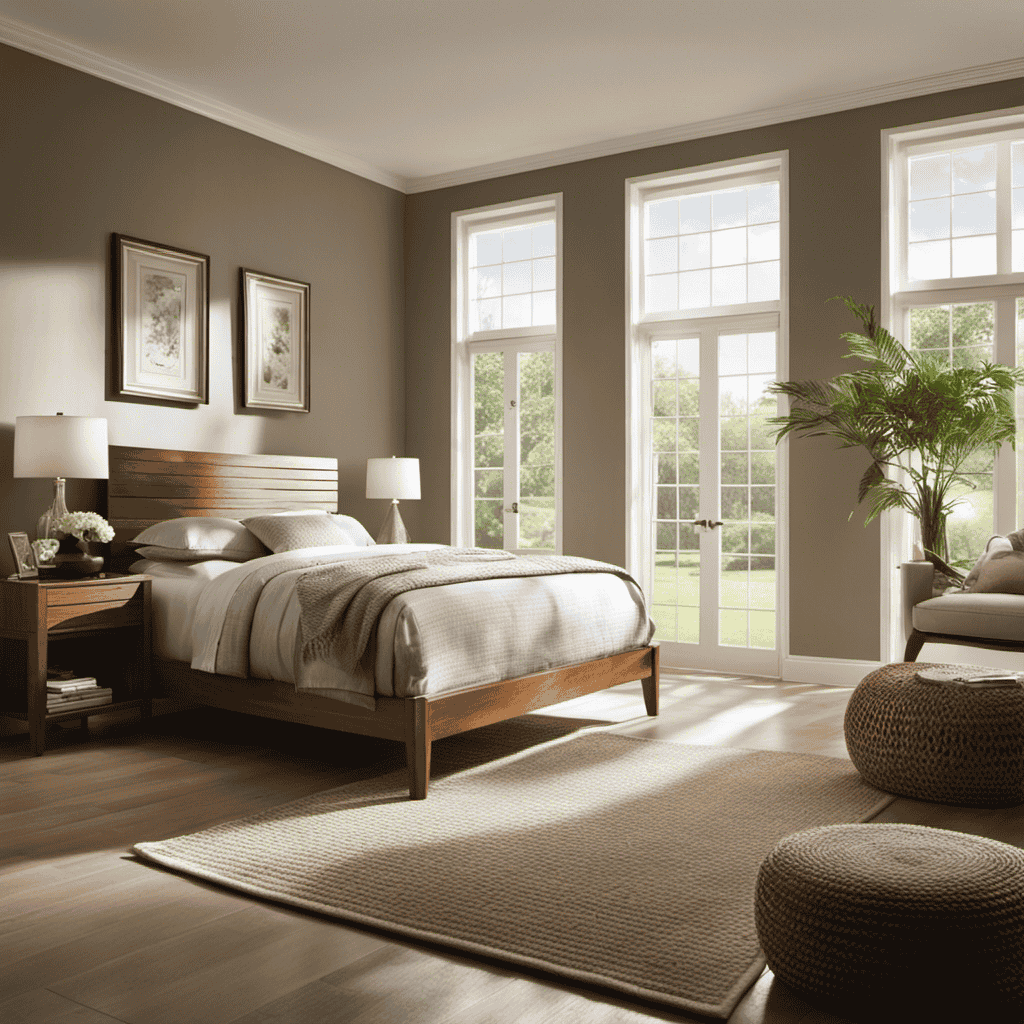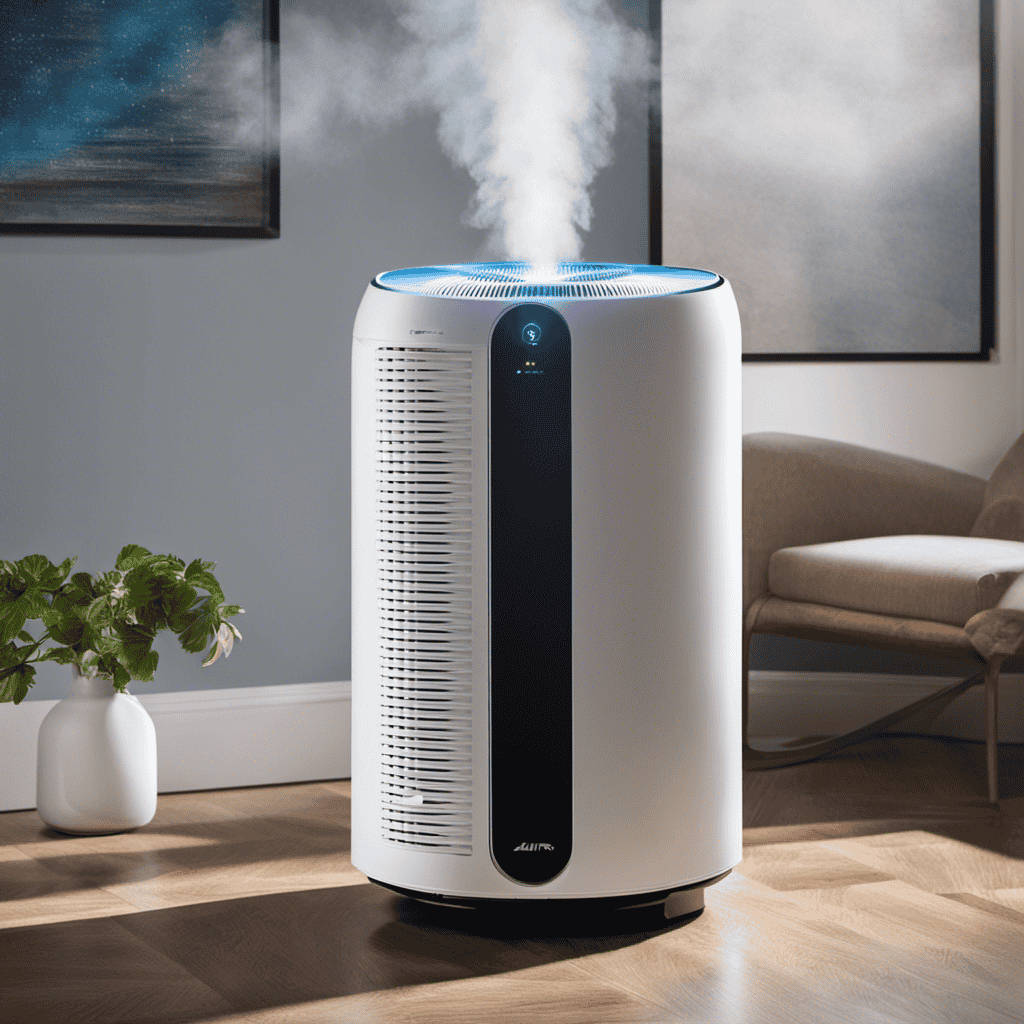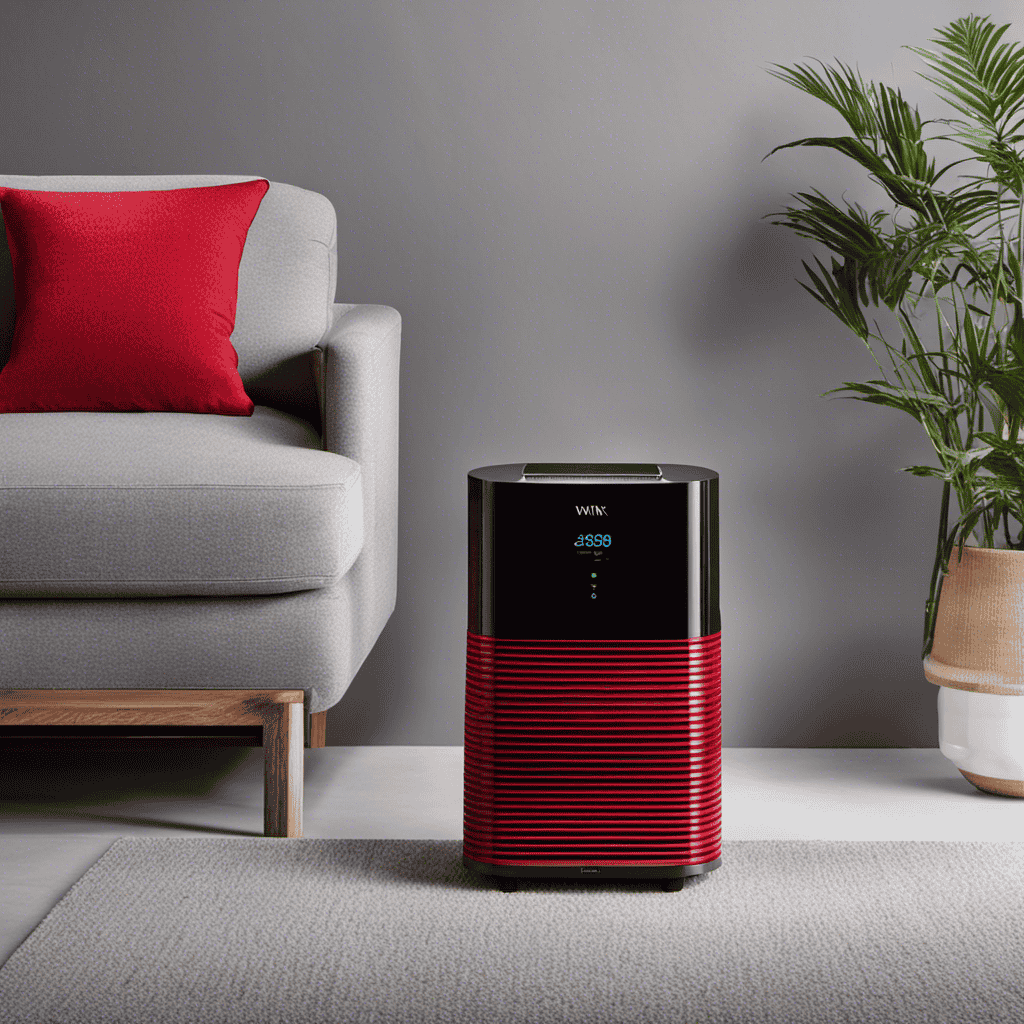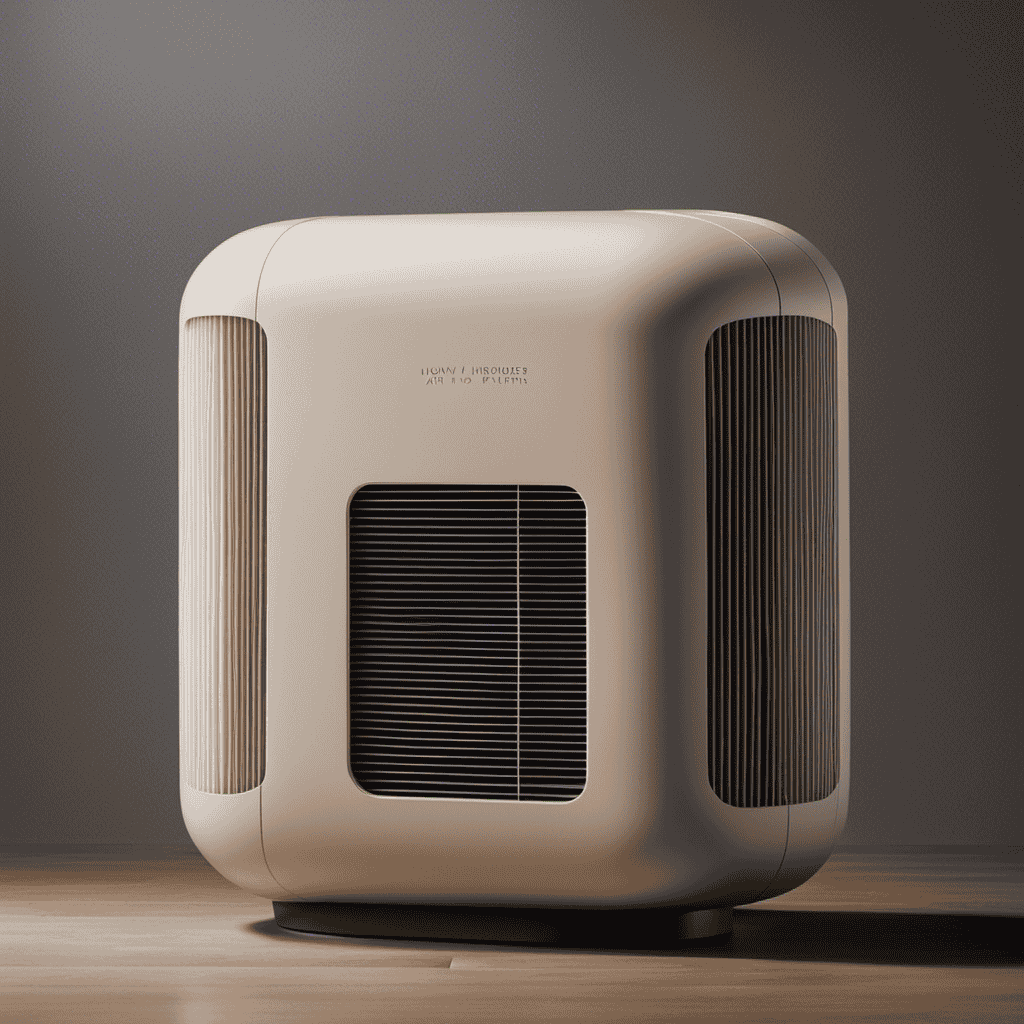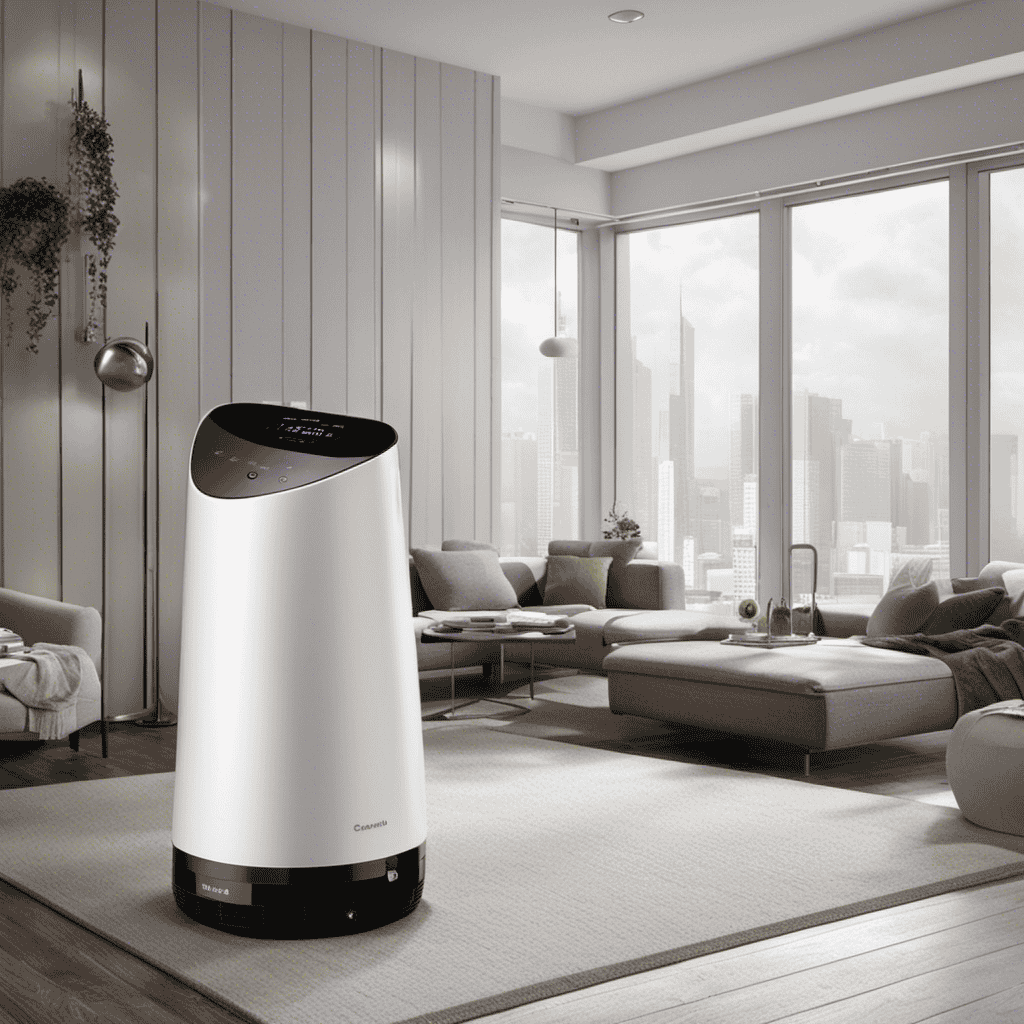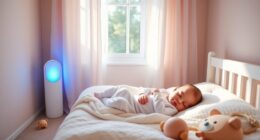Are you exhausted from constantly fighting allergies and asthma symptoms? Searching for a solution to enhance your indoor air quality? Look no further!
In this article, I’ll be sharing with you the benefits of air purifiers for allergies and asthma. We’ll explore how these devices can effectively remove common triggers from the air, the different types of air purifiers available, and key features to consider when choosing one.
So, let’s dive in and discover how air purifiers can bring you relief and peace of mind.
Key Takeaways
- Air purifiers can help improve indoor air quality by reducing allergens and irritants like dust, pet dander, pollen, and mold spores.
- High-efficiency particulate air (HEPA) filters are the most effective in removing allergens, while activated carbon filters are effective at removing odors and chemical pollutants.
- Reputable brands for air purifiers include Dyson, Honeywell, and Blueair, which offer various features such as HEPA filters, air quality sensors, Wi-Fi connectivity, and different room coverage options.
- Consulting with a healthcare professional can provide valuable insights and recommendations on choosing the right air purifier for allergies and asthma.
Understanding Allergies and Asthma
If you have allergies or asthma, it’s important to understand how they can affect your daily life.
Allergies and asthma are both conditions that can be triggered by various factors. Common allergy triggers include pollen, dust mites, pet dander, and mold. When exposed to these triggers, individuals with allergies may experience symptoms such as sneezing, itching, and nasal congestion.
On the other hand, asthma is a chronic respiratory condition characterized by inflammation and narrowing of the airways. Asthma symptoms can include wheezing, shortness of breath, and chest tightness.
It’s crucial to identify and avoid these triggers to manage allergies and asthma effectively. In addition to trigger avoidance, there are various treatments available for both allergies and asthma.
Allergy treatments may include over-the-counter antihistamines, nasal sprays, and allergy shots. Asthma treatments, on the other hand, may involve the use of inhalers, bronchodilators, and corticosteroids. These treatments help to relieve symptoms and prevent asthma attacks.
Understanding the triggers and treatments for allergies and asthma is essential in maintaining a good quality of life for individuals with these conditions.
Common Triggers for Allergies and Asthma
Common triggers for allergies and asthma include dust mites, pollen, pet dander, and mold. As someone who suffers from allergies and asthma, managing these triggers is essential for me to maintain a good quality of life.
Dust mites, microscopic insects found in bedding, carpets, and upholstery, can cause allergy symptoms such as sneezing, itching, and congestion. Pollen, which is released by plants, can be inhaled and trigger allergy symptoms like watery eyes and runny nose. Pet dander, the tiny flakes of skin shed by animals, can also lead to allergies and asthma attacks. Mold, a type of fungus that thrives in damp environments, can release spores that trigger respiratory symptoms.
To manage these triggers, I have implemented various strategies. Firstly, I make sure to keep my living space clean and free of dust by regularly vacuuming, dusting, and washing bedding. I also try to limit my exposure to pollen by checking the pollen count and staying indoors when levels are high. Additionally, I take steps to minimize pet dander by keeping my pets out of my bedroom and regularly grooming them. Lastly, I control mold by keeping my home dry, using dehumidifiers, and promptly addressing any water leaks or moisture issues.
How Air Purifiers Can Help
To effectively manage your respiratory symptoms, it’s important to consider how air purifiers can assist you. Air purifiers play a crucial role in improving indoor air quality by reducing indoor pollutants. These devices are designed to filter out common allergens and irritants, such as dust, pet dander, pollen, and mold spores, which can trigger allergies and asthma symptoms.
One of the key benefits of air purifiers is their ability to remove airborne particles from the air. These particles can be as small as 0.3 microns in size, and they can easily infiltrate our homes and cause respiratory issues. Air purifiers use filters to trap these particles and prevent them from circulating in the air we breathe. By reducing the number of airborne allergens and irritants, air purifiers can help alleviate symptoms and improve overall respiratory health.
In addition to filtering out allergens, air purifiers can also help eliminate odors and harmful chemicals from the air. Many air purifiers are equipped with activated carbon filters that can absorb and neutralize unpleasant smells, such as cigarette smoke or cooking odors. They can also remove volatile organic compounds (VOCs) that may be emitted by household products, such as cleaning supplies and paints.
Overall, air purifiers are an effective tool in reducing indoor pollutants and improving indoor air quality. By investing in a high-quality air purifier, you can create a cleaner and healthier living environment, which can have a positive impact on your respiratory health.
Types of Air Purifiers for Allergies and Asthma
There are different types of air purifiers available that can be beneficial for managing respiratory symptoms caused by allergies and asthma. When it comes to filter technologies, there are a few options to consider.
High-efficiency particulate air (HEPA) filters are widely regarded as the most effective in removing allergens and pollutants from the air. These filters can capture particles as small as 0.3 microns, including dust mites, pollen, pet dander, and mold spores.
Another type of filter technology is activated carbon filters, which are effective at removing odors and chemical pollutants. They work by adsorbing these substances onto their surface.
In terms of purifier brands, there are several reputable options available. One well-known brand is Dyson, which offers air purifiers with HEPA filters and additional features like air quality sensors and Wi-Fi connectivity. Another popular brand is Honeywell, which offers a range of air purifiers with HEPA filters and different room coverage options. Blueair is another brand known for its high-performance air purifiers, particularly those with HEPASilent technology, which combines mechanical and electrostatic filtration.
When choosing an air purifier for allergies and asthma, it’s important to consider the specific needs and preferences of the individual. Consulting with a healthcare professional can also provide valuable insights and recommendations.
Key Features to Look for in an Air Purifier
When it comes to choosing an air purifier, there are a few key features that are important to consider.
One of the most crucial factors is the type and effectiveness of the filter used in the purifier. Different filters target different pollutants, so it’s essential to choose one that fits your specific needs.
Additionally, noise level considerations are also important, as some purifiers can be quite loud and disruptive in a quiet environment.
Filter Types and Effectiveness
HEPA filters are highly effective at trapping allergens and asthma triggers. They are the gold standard when it comes to air purifier effectiveness. However, there are also other filter types that can be beneficial in reducing allergens and asthma triggers in the air. Let’s take a look at some of the different filter types and their effectiveness:
| Filter Type | Effectiveness |
|---|---|
| HEPA | Highly effective |
| Carbon | Effective |
| Ionizer | Moderate |
| UV-C | Limited |
HEPA filters are known for their ability to capture particles as small as 0.3 microns with a 99.97% efficiency. Carbon filters are effective at removing odors and chemicals. Ionizers can help remove particles from the air but may produce ozone. UV-C filters use ultraviolet light to kill germs and bacteria, but their effectiveness may be limited. Considering the filter type is essential for choosing the right air purifier for your needs.
Now that we understand the different filter types and their effectiveness, let’s delve into another important consideration: noise level.
Noise Level Considerations
To choose the right air purifier for your needs, you’ll want to consider the noise level it produces. While a quiet air purifier is desirable, it’s important to strike a balance between noise and performance.
Here are some factors to consider:
- Placement: Placing the air purifier in a corner or against a wall can help reduce noise levels.
- Soundproofing options: Using soundproof curtains or placing the air purifier in a soundproof enclosure can help minimize noise.
- Acoustic panels: These absorb sound waves and reduce echo, making the purifier quieter.
- Weatherstripping: Applying weatherstripping around the air purifier can help seal any gaps and reduce noise leakage.
Choosing the Right Size and Capacity
When selecting an air purifier, there are several key points to consider:
-
Room size: It’s important to determine the size of the room where you plan to use the air purifier. This will help ensure that the purifier is able to effectively clean the air in the entire space.
-
Airflow and coverage: Considering the airflow and coverage of the purifier is crucial in order to ensure optimal performance and efficiency.
-
Filter replacement frequency: Lastly, filter replacement frequency is an important factor to keep in mind as it will impact the long-term maintenance and cost of the air purifier.
Room Size Considerations
Make sure you measure the size of your room before purchasing an air purifier. Room size limitations are an important factor to consider when choosing an air purifier. To ensure the effectiveness of the purifier, it is crucial that it can adequately cover the square footage of your room.
Here are some considerations to keep in mind:
-
Coverage area: Look for the purifier’s recommended coverage area, which is typically mentioned in the product specifications. This will help you determine if it is suitable for your room size.
-
Air changes per hour (ACH): A higher ACH rating indicates that the purifier can filter the air in your room more frequently, which can improve its effectiveness in capturing allergens and asthma triggers.
-
CADR rating: The Clean Air Delivery Rate (CADR) measures the purifier’s ability to remove pollen, dust, and smoke from the air. Higher CADR ratings are generally better for larger rooms.
Airflow and Coverage
By considering the size of your room, you can ensure that the air purifier adequately covers the space and improves air quality. One important factor to consider is airflow control. A good air purifier should have adjustable airflow settings that allow you to control the speed and intensity of the air purification process. This is especially important if you have allergies or asthma, as certain allergens and irritants may require stronger airflow to be effectively removed from the air.
Another crucial aspect to consider is the purifier coverage area. Different air purifiers have different coverage areas, which indicate the maximum square footage they can effectively clean. It is essential to choose an air purifier that matches the size of your room, so it can efficiently filter the air and provide you with clean, allergen-free air.
Filter Replacement Frequency
To ensure optimal performance, you’ll need to regularly replace the filters in your air purifier. Regular filter replacement is essential for maintaining clean and healthy air in your home. Here are some key benefits of regular filter replacement:
-
Improved Air Quality: Air purifiers capture and trap airborne particles, such as dust, pollen, pet dander, and mold spores. By regularly replacing the filters, you ensure that these particles are effectively removed from the air, leading to improved indoor air quality.
-
Extended Lifespan: When filters are clogged with pollutants, the air purifier has to work harder to circulate air. This can put strain on the motor, reducing its lifespan. Regular filter replacement helps maintain the efficiency of the air purifier, extending its overall lifespan.
Cost-Effective Options:
-
Washable Filters: Some air purifiers come with washable filters, which can be reused after cleaning. These filters provide a cost-effective option as they eliminate the need for frequent replacements.
-
Filter Subscription Services: Many manufacturers offer filter subscription services, where you can sign up to receive regular filter replacements at a discounted price. This ensures you never forget to replace your filters and saves you money in the long run.
Regular filter replacement is not only important for the performance and lifespan of your air purifier but also for the health and well-being of you and your family. Now that you understand the benefits of regular filter replacement, let’s explore some maintenance and cleaning tips for air purifiers.
Maintenance and Cleaning Tips for Air Purifiers
Regularly cleaning the filters and wiping down the exterior of your air purifier will help maintain its effectiveness in reducing allergens and asthma triggers. Cleaning techniques for air purifiers may vary depending on the model and manufacturer’s instructions. However, there are some general maintenance practices that can be followed.
First, it is important to establish a regular maintenance schedule for your air purifier. This will ensure that it continues to operate efficiently and effectively. Check the manufacturer’s guidelines to determine how often the filters should be cleaned, as this can vary depending on the type of filter used. Some filters may need to be replaced, while others can be cleaned and reused.
To clean the filters, start by turning off and unplugging the air purifier. Remove the filters according to the manufacturer’s instructions. Gently vacuum or brush away any visible dust or debris from the filters. If the filters are washable, rinse them with water and mild soap. Allow them to air dry completely before reinserting them into the air purifier.
In addition to cleaning the filters, it is also important to regularly wipe down the exterior of the air purifier. Use a soft, damp cloth to remove any dust or dirt that may have accumulated. Pay close attention to the vents and grilles, as these areas can easily become clogged and affect the performance of the air purifier.
The Importance of HEPA Filters
Make sure you understand the importance of HEPA filters in reducing airborne contaminants and improving indoor air quality. HEPA stands for High Efficiency Particulate Air, and these filters are designed to capture 99.97% of particles as small as 0.3 microns.
Here are some key benefits of HEPA filtration:
-
Removes Allergens: HEPA filters are highly effective in trapping allergens such as pollen, pet dander, and dust mites. This can provide relief for individuals with allergies or asthma.
-
Traps Harmful Particles: HEPA filters can capture harmful particles like bacteria, viruses, and smoke, improving the overall air quality in your home.
-
Reduces Respiratory Issues: By filtering out airborne pollutants, HEPA filters can help reduce respiratory issues like coughing, wheezing, and shortness of breath.
Additionally, HEPA filters can help prolong the lifespan of your air purifier by preventing large particles from clogging the system. It is important to note that regular maintenance and filter replacement are necessary to ensure optimal performance.
Understanding the benefits of HEPA filtration can help you make an informed decision when choosing an air purifier for your home.
Additional Filters and Technologies to Consider
In addition to HEPA filters, there are several other filters and advanced technologies that can enhance the effectiveness of air purifiers for allergies and asthma. These additional features can help to further reduce airborne particles, allergens, and irritants in the air, providing cleaner and healthier indoor environments.
One such feature is an activated carbon filter. Activated carbon is highly porous and can effectively capture gases, odors, and chemicals. This filter works by adsorbing these substances onto its surface, effectively removing them from the air.
Another technology to consider is ultraviolet (UV) light. UV light has been shown to be effective in killing bacteria, viruses, and mold spores. Air purifiers equipped with UV-C lights can help to neutralize these microorganisms, reducing the risk of respiratory infections.
Some air purifiers also come with ionizers. These devices release charged ions into the air, which attach to airborne particles and cause them to clump together. Once the particles are larger, they are easier to capture by the filters.
It is worth noting that while these additional features and advanced technologies can enhance the performance of air purifiers, they should not replace the importance of a HEPA filter. HEPA filters are still the gold standard when it comes to removing allergens and particles from the air.
Therefore, it is recommended to choose an air purifier that combines HEPA filtration with these additional features and technologies for optimal results.
Noise Levels and Energy Efficiency
Consider how noisy or quiet the air purifier is and how energy efficient it is to ensure it meets your needs. When choosing an air purifier, you want to find a balance between effective filtration and a noise level that won’t disturb your daily activities. Look for models with noise reduction features, such as a low-speed mode or a quiet fan motor, which can help minimize the noise level while still providing efficient air purification.
To help you make an informed decision, here are some key factors to consider:
-
Noise Reduction:
-
Look for air purifiers with adjustable fan speeds. This allows you to customize the noise level based on your preference and the time of day.
-
Consider models with noise reduction technologies, such as insulated filters or sound-dampening materials, which can help minimize noise without compromising performance.
-
Energy Saving Features:
-
Opt for air purifiers with energy-saving modes or timers. These features allow you to set specific operating hours, reducing energy consumption and saving you money on electricity bills.
-
Look for models with Energy Star certification, as these have been tested and proven to meet strict energy efficiency standards.
Placement and Positioning for Maximum Effectiveness
When it comes to optimizing the placement of an air purifier, there are a few key considerations to keep in mind.
Firstly, it is important to place the purifier in a central location within the room to ensure that the air is effectively circulated.
Additionally, taking into account the layout of the room, such as the presence of obstacles or furniture, can help to maximize the purifier’s performance by allowing for unobstructed airflow.
Optimal Purifier Placement
For the best results, place your air purifier in a central location within the room to effectively reduce allergens and improve air quality. This placement ensures that the purifier can circulate air evenly throughout the space, optimizing its effectiveness.
To further enhance the performance of your air purifier, consider the following:
- Keep the purifier away from walls and furniture to allow for optimal airflow.
- Avoid placing the purifier near sources of dust or chemicals, such as open windows or cleaning supplies.
Maintaining your air purifier is crucial for its long-term performance and effectiveness. Here are some tips for purifier maintenance:
- Regularly clean or replace the filters as recommended by the manufacturer to ensure efficient filtration.
- Keep the exterior of the purifier clean by wiping it down with a damp cloth to prevent dust buildup.
Room Layout Considerations
To optimize the effectiveness of your air purifier, make sure to arrange the furniture in your room in a way that allows for proper airflow and circulation.
When it comes to furniture placement, there are a few key considerations to keep in mind.
First, avoid blocking the air purifier with large pieces of furniture, such as couches or bookshelves. This can impede the airflow and reduce the purifier’s ability to clean the air efficiently.
Additionally, consider the color choices for your room. Lighter colors tend to reflect more light and make a room feel more spacious, whereas darker colors can absorb light and make a space feel smaller.
Reviews and Recommendations: Top Air Purifiers for Allergies and Asthma
Our top recommendations for air purifiers that can help with allergies and asthma are the Honeywell True HEPA Allergen Remover and the Coway Mighty Air Purifier. These air purifiers are designed to effectively remove air pollutants and improve indoor air quality, providing relief for those with allergies and asthma.
Understanding Air Pollutants:
- Air pollutants can include allergens such as dust mites, pollen, pet dander, and mold spores. These particles can trigger allergies and asthma symptoms, causing discomfort and breathing difficulties.
- Volatile organic compounds (VOCs) are another common type of air pollutant. They are released from household products, such as cleaning supplies, paints, and furniture, and can contribute to respiratory irritation.
Benefits of Air Purifiers:
- Air purifiers with HEPA filters can capture and trap airborne particles as small as 0.3 microns, effectively removing allergens and other pollutants from the air.
- Activated carbon filters in air purifiers help to eliminate odors and VOCs, improving indoor air quality and creating a healthier living environment.
Investing in a high-quality air purifier can greatly benefit individuals with allergies and asthma. The Honeywell True HEPA Allergen Remover and the Coway Mighty Air Purifier are both excellent options that have received positive reviews for their performance in reducing allergens and improving indoor air quality.
Frequently Asked Questions
Are Air Purifiers Effective in Reducing Pet Dander and Allergens?
Yes, air purifiers can be effective in reducing pet dander and allergens. They work by filtering the air and trapping particles like pet dander, pollen, and dust mites. This helps improve indoor air quality and reduces allergens that can trigger allergies and asthma symptoms.
However, the effectiveness of air purifiers may vary depending on factors such as the size of the purifier, the level of pollutants in the air, and how well the purifier is maintained.
Can Air Purifiers Eliminate All Types of Mold Spores?
Air purifiers are an effective tool for mold prevention. They can help eliminate various types of mold spores in the air, improving indoor air quality.
Using air purifiers for mold control has several benefits, such as reducing the risk of respiratory issues and allergies caused by mold exposure. These devices work by filtering out mold spores and other airborne particles, trapping them in the filter.
Regular maintenance and proper placement are important for optimal performance.
What Is the Lifespan of a HEPA Filter and How Often Should It Be Replaced?
The lifespan of a HEPA filter and how often it should be replaced are important considerations. HEPA filters typically last around 6 to 12 months, depending on usage and air quality. However, it’s essential to remember that the replacement frequency can vary based on individual circumstances.
Regularly inspecting the filter and following the manufacturer’s recommendations is vital to ensure optimal performance. Proper maintenance and timely replacement of the HEPA filter can help maintain clean and allergen-free air in your space.
Do Air Purifiers Remove Odors From the Air?
Yes, air purifiers can remove odors from the air.
I once had a roommate who smoked cigarettes in our apartment. The smell was overpowering and made it difficult to breathe.
I decided to invest in an air purifier specifically designed to combat cigarette smoke. It made a significant difference in the air quality and eliminated the lingering odor.
Additionally, air purifiers can also help remove kitchen odors, making your home smell fresh and clean.
Can Air Purifiers Help With Respiratory Conditions Other Than Allergies and Asthma?
Air purifiers can be beneficial for respiratory conditions beyond allergies and asthma. They can help improve air quality for individuals with COPD, reducing their exposure to irritants and pollutants.
Additionally, air purifiers can help reduce the spread of respiratory infections by filtering out airborne viruses and bacteria.
While they cannot cure or prevent these conditions, using air purifiers as part of a comprehensive treatment plan may provide some relief and improve overall respiratory health.
Conclusion
After researching the benefits of air purifiers for allergies and asthma, I am convinced that investing in one is a wise decision. These devices can effectively remove allergens and irritants from the air, providing relief and improving overall air quality.
In fact, studies have shown that air purifiers can reduce symptoms and improve lung function for those with respiratory conditions. It’s like having a superhero in your home, fighting off the invisible villains that trigger your allergies and asthma.
So why wait? Take control of your health and breathe easier with an air purifier.
